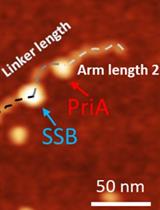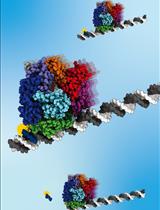- EN - English
- CN - 中文
Structural Based Strategy for Predicting Transcription Factor Binding Sites
采用结构型策略预测转录因子结合位点
发布: 2013年06月20日第3卷第12期 DOI: 10.21769/BioProtoc.794 浏览次数: 9113
评审: Fanglian HeLin FangAnonymous reviewer(s)
Abstract
Scanning through genomes for potential transcription factor binding sites (TFBSs) is becoming increasingly important in this post-genomic era. The position weight matrix (PWM) is the standard representation of TFBSs utilized when scanning through sequences for potential binding sites. Many transcription factor (TF) motifs are short and highly degenerate, and methods utilizing PWMs to scan for sites are plagued by false positives. Furthermore, many important TFs do not have well-characterized PWMs, making identification of potential binding sites even more difficult. One approach to the identification of sites for these TFs has been to use the 3D structure of the TF to predict the DNA structure around the TF and then to generate a PWM from the predicted 3D complex structure. However, this approach is dependent on the similarity of the predicted structure to the native structure. We introduce here a novel approach to identify TFBSs utilizing structure information that can be applied to TFs without characterized PWMs, as long as a 3D complex structure (TF/DNA) exists. Our approach utilizes an energy function that is uniquely trained on each structure thus leads to increased prediction accuracy and robustness compared with those using a more general energy function. The software is freely available upon request. Please see reference supplementary material for details.
Keywords: ChIP-Seq (ChIP-seq)Data and Software
- TF/DNA structure
tFIRE takes standard PDB format for TF/DNA structures.- A good place to look for such data is PDB (Rose et al., 2011) (http://www.pdb.org).
- If the TF/DNA complex structure does not exist but the TF structure exists, you can generate the TF/DNA structure by docking DNA to the TF structure. Software that can be utilized for this includes HADDOCK (De Vries et al., 2007) (http://www.nmr.chem.uu.nl/haddock), FTDOCK (Jackson R.M. et al., 1998) (http://www.sbg.bio.ic.ac.uk/docking/ftdock.html), YASARA DOCK (http://www.yasara.org/dnadock.htm), ParaDock (Banitt and Wolfson, 2011) (http://www.paradocks.org). Our method indicates that such docking will not affect a result significantly but we have not tested any of these docking predictions ourselves for validation. Hence we urge their use with caution, and revalidate the results once the structures are available.
- If the TF structure does not exist in 3D structure databases, you can predict TF structure using homology modeling like SWISS-MODEL (Guex and Peitsch, 1997) (http://swissmodel.expasy.org), Rosetta (Bradley et al., 2003) (https://www.rosettacommons.org), Sybyl (Visegrády et al., 2001) (http://www.tripos.com/index.php?family=modules,SimplePage,,,&page=SYBYL-X). Please use with caution that each prediction step would reduce the accuracy.
- Predict TFBSs
tFIRE predicted motif(PWM) can be used to predict TFBSs.- Motif scanning programs can be used to scan the whole genome for motif matches. Such methods included MAST (Bailey et al., 2006) (http://meme.nbcr.net/meme/cgi-bin/mast.cgi) from MEME suite and STORM (Schones et al., 2007) (http://rulai.cshl.edu/storm) from Cold Spring Harbor Laboratory.
- TFBSs vary for different cells. Recently, a newly developed method, CENTIPEDE (Pique-Regi et al., 2010) (http://centipede.uchicago.edu) shows that with the result from a single DNase-seq experiment, one can accurately predict TFBSs for all TFs. Therefore, downloading DNase-seq data from ENCODE project can be very helpful.
- Recently developed FAIRE-seq technology allow similar predictions for detection of chromatin accessibility regions (Song et al., 2011). Such data can be substituted for DNase-seq, but needs be tested and validated before use.
- Epigenetic information can also be employed instead of DNase-seq (Cuellar-Partida et al., 2012). We propose to update our data and methods available for such predictions on a regular basis.
- Software
- C++ software environment, better with Linux system
- tFIRE, Feel Free to ask the author for a linux version
- WebLogo (Crooks et al., 2004) can be used for visualization the PWM we predicted (http://weblogo.berkeley.edu)
Procedure
文章信息
版权信息
© 2013 The Authors; exclusive licensee Bio-protocol LLC.
如何引用
Xu, B., Wang, Y., Liang, H. and Li, G. (2013). Structural Based Strategy for Predicting Transcription Factor Binding Sites . Bio-protocol 3(12): e794. DOI: 10.21769/BioProtoc.794.
分类
分子生物学 > DNA > DNA-蛋白质相互作用
您对这篇实验方法有问题吗?
在此处发布您的问题,我们将邀请本文作者来回答。同时,我们会将您的问题发布到Bio-protocol Exchange,以便寻求社区成员的帮助。
Share
Bluesky
X
Copy link












